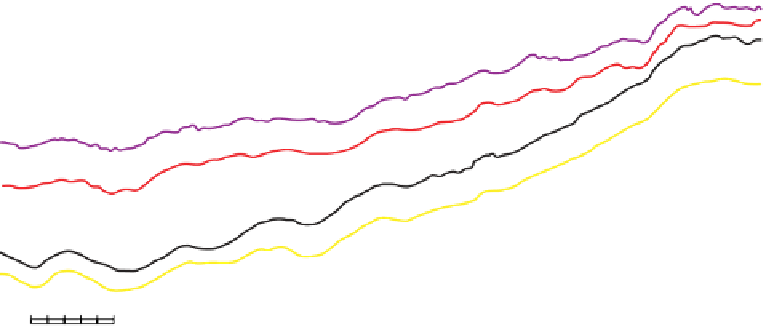Geoscience Reference
In-Depth Information
3000
N
S
3100
3200
3300
3400
3500
3600
3700
3800
2.5 km
3900
3000
N
S
3100
3200
3300
3400
3500
F
3600
3700
Truncation
Onlap
Interpreted limit of the
channel structure
Top Ekofisk Fm
Top Tor Fm
3800
2.5 km
Middle Tor SB
3900
Top Magne Fm
Top Thud Fm
Top Narve Fm
Top Blodøks Fm
Base Hidra Fm
F
Fault
Fig. 3.
Reflection configuration and terminations within the seismic units of the Chalk Group (cf. stratigraphy in Fig. 2);
note the location of the studied channel.
upper boundary of the Tor Formation (light green
horizon of Figs 3, 5, 6 and 7) and the base of the
Danian clay-rich Ekofisk dense zone.
Biostratigraphic dating of the Tor Formation is
based on nannofossil and microfossil data docu-
mented in well reports, from the cored intervals of
well 2/4-12 (Martsolf, 1994), wells 2/4-A8 and
2/7-4 (Bailey
et al
., 1999) and well 2/7-14 (Young &
Yang Logan, 1994). The biostratigraphic dates indi-
cate that the upper sequence is upper Maastrichtian,
corresponding to the UC19 and UC20 nannofossil
zones (Fig. 2) (Bailey
et al
., 1999). Biofacies are
dominated by planktonic and benthic foraminifera.
In well 2/7-14, radiolarians have been noted in the
intervals 3278 m to 3290 m and 3308 m to 3310 m.
Ostracods,
Inoceramus
bivalve fragments and
scaphopods are also present but do not provide
useful biostratigraphic datings.
Seismic evidence of the channel
Seismic amplitude mapping of the top Tor
Formation reflector reveals a distinctive strong
negative amplitude in the region adjacent to wells


































Search WWH ::

Custom Search